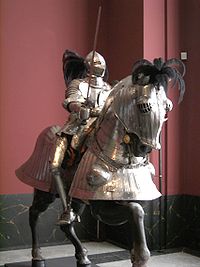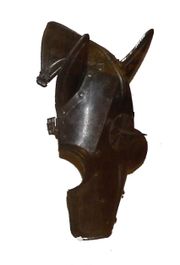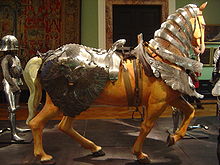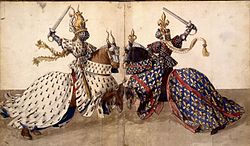- Barding
-
For the culinary practice of adding fat strips to a roast, see barding and larding.
Barding (also spelled bard or barb) is armour for horses. During the late Middle Ages as armour protection for knights became more effective, their mounts became targets. This tactic was effective for the Scots at the Battle of Bannockburn in the fourteenth century when horses were killed by the infantry and the English at the Battle of Crécy in the fourteenth century where archers shot horses and heavy infantry killed the French knights after they were dismounted. Barding developed as a response to such events.
Surviving period examples of barding are rare; however, complete sets are on display at the Wallace Collection in London, and the Royal Armouries in Leeds.
Contents
Champron
The champron (also spelled champion, chamfron, chamfrein, and shaffron) was designed to protect the horse's face. Sometimes this included hinged cheek plates. A decorative feature common to many champrons is a rondel with a small spike.[1]
The champron originated in ancient Greece, but vanished from use until the twelfth century when metal plates replaced boiled leather as protection for war horses. The basic design of the champron remained stable until it became obsolete in the seventeenth century, although late examples are often notable for engraved decoration. A champron extended from the horse's ears to its muzzle. Flanges often covered the eyes. In an open champron, the eyes received no protection. Hinged extensions to cover the jowls were commonly used for jousting tournaments.[2]
The enigmatic Torrs pony-cap from Scotland appears to be a bronze champron from about the 2nd century BC, perhaps later fitted with the bronze horns found with it.
Criniere
A set of armour with a criniere (protecting neck), peytral (protecting chest) and the croupiere (protecting hind quarters). Kunsthistorisches Museum, Vienna, Austria.
The criniere (also known as manefaire or crinet) was a set of segmented plates that protected the horse's neck.
In full barding this consisted of two combinations of articulated lamés that pivoted on loose rivets. One set of lames covered the mane and the other covered the neck. These connected to the peytral and the champron.[3]
Light barding used only the upper lamés. Three straps held the criniet in place around the neck.[3] It is thought that thin metal was used for these plates, perhaps 22 gauge. Chainmail was often affixed to the crinet and wrapped about the horse's neck for additional protection.
Croupiere
The croupiere (also crupiere bacul or crupper) protected the horse's hind quarters. It could be made from any combination of leather, chain, or plate.
Flanchard
The flanchards, used to protect the flank, attached to the side of the saddle, then around the front or rear of the horse and back to the saddle again. These appear to have been metal plates riveted to leather or in some cases cuirboille armour (which is boiled or treated leather sealed with beeswax or the like).
They sometimes had openings designed to allow the rider to use spurs.
Peytral
The peytral was designed to protect the chest of the horse, while the croupiere protected the rear. It sometimes stretched as far back as the saddle.
Caparisons
Barding was often used in conjunction with cloth covers known as caparisons. These coverings sometimes covered the entire horse from nose to tail and extended to the ground. It is unclear from period illustrations how much metal defensive covering was used in conjunction. Textile covers may also be called barding.
Other features
Another commonly included feature of barding was protection for the reins, so they could not be cut. This could be metal plates riveted to them as seen in the images here, or chainmail linked around them.
See also
Notes
References
- Broughton, Branford B. Dictionary of Medieval Knighthood and Chivalry: Concepts and Terms, (Westport, Connecticut: Greenwood Press, 1986).
- Mondadore, Arnoldo, ed. The Complete Encyclopedia of Arms & Weapons, (New York:Simon & Schuster, 1979).
- Stone, George Cameron (1934). A Glossary of the Construction, Decoration, and Use of Arms and Armor in All Countries and in All Times, Mineola: Dover Publications. ISBN 0-486-40726-8
External links
- Overview of Bards images of barding from period documents
Categories:- Horse protective equipment
- Barding
Wikimedia Foundation. 2010.




